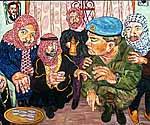Keeping the peace: Education Activities
- Activities
- Case study
- Day in the life
- Peacekeeping quiz
Arriving
Peacekeepers come from all over the world. They and their equipment can arrive by air, land or sea. Each type of transport requires its own special duties and skills.
Lynne Norton, HMAS Sydney and HMAS Brisbane at HMAS Stirling WA, 19/11/90 en route to the Gulf
UN
The United Nations is a very large international organisation and consists of people from all over the world. Because of the very important and sometimes dangerous nature of its work the people who work for it need to be very skillful and well trained.

George Gittoes, A Plea for Peace Keepers (ART91481)
The Task
The task of helping people can be huge. It can be likened to rebuilding a house that has been destroyed. Rebuilding involves detailed planning, hard work and organisation. It involves working very closely with all sorts of people.
Wendy Sharpe, On Patrol, near Suai (Wendy Sharpe, Private Cameron Simpson and unidentified soldier)
How would you feel?
Being away from home can be very difficult. Seeing people suffer can be very unpleasant and disturbing. These are feelings that people who work for the UN need to understand and to deal with on a daily basis.
Julie and Jodie
Working as a peacekeeper in another country requires a strong personal awareness of and respect for people of other religions and cultures. Working with people and respecting people produces quicker and more positive results.
George Gittoes, Corporal Julie Baranowski, Military Police, searching Somali women
National Statements and Profiles
The questions and activities address a range of outcomes under each of the five strands of the National Statements and Profiles. These are: Time, Continuity and Change, Place and Space, Culture, Resources, Natural and Social Systems and Investigation, Communication and Participation.
About the Activities
The activities focus on artworks by the artists Rick Amor, Wendy Sharpe, George Gittoes, Robert McCrae, Lynne Norton and Christian Clare Robertson and can be used as either pre- or post-visit activities. Students are encouraged to explore the artwork of the exhibition and select an activity or question that appeals to them personally. The activities encourage students to develop the ability to investigate and communicate. They can place themselves in the position of a peacekeeper where they are required to find solutions and solve problems in a wide range of circumstances.
This material is designed to provide teachers with a set of art based activities that will allow students to explore the concepts and issues raised in each artwork. It is hoped that the material can be used not only as activity sheets but also as a general stimulus and resources for teachers to use over a range of subjects and settings.
The material has not been designed with any particular age group in mind. There are issues and activities that have the potential to challenge students over a wide range of ages and abilities.
The headings under which the paintings are organised are designed to allow students to relate to the 'job' or the day to day activity of peacekeeping.












